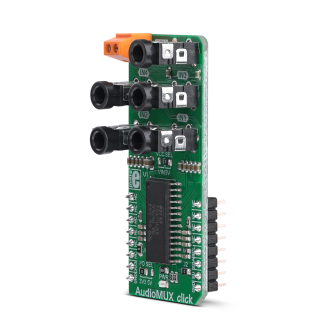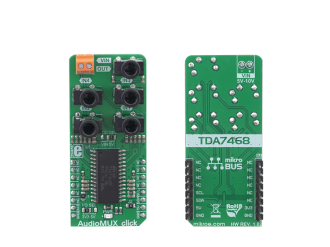
We strongly encourage users to use Package manager for sharing their code on Libstock website, because it boosts your efficiency and leaves the end user with no room for error. [more info]

Rating:
Author: MIKROE
Last Updated: 2019-01-18
Package Version: 1.0.0.0
mikroSDK Library: 1.0.0.0
Category: Signal processing
Downloaded: 4965 times
Not followed.
License: MIT license
AudioMUX click is a sound processing Click board with digital controls, based on the TDA7468D IC.
Do you want to subscribe in order to receive notifications regarding "AudioMUX click" changes.
Do you want to unsubscribe in order to stop receiving notifications regarding "AudioMUX click" changes.
Do you want to report abuse regarding "AudioMUX click".


Library Description
Library offers a choice to perform a control of the AudioMUX Click board. The control consists of input control, output control, gain control, volume control, treble and bass control... The device also can work in Bass ALC Mode by using this library. For more details check documentation.
Key functions:
T_AUDIOMUX_RETVAL audiomux_writeSingleByte( uint8_t regAddr, uint8_t dataIn ) - Function writes one byte data to the register.T_AUDIOMUX_RETVAL audiomux_selectInput( uint8_t inputSel, uint8_t muteIn, uint8_t micGain, uint8_t micState ) - Function performs a input selection and control.T_AUDIOMUX_RETVAL audiomux_setVolume( uint8_t volume1, uint8_t volume2, uint8_t sideSel )- Function performs a left or right volume control.T_AUDIOMUX_RETVAL audiomux_setTrebleBass( uint8_t treble, uint8_t bass ) - Function performs a control of the treble and bass for EQ section.Examples description
The application is composed of the three sections :
void applicationTask()
{
if (initCheck == 0)
{
audiomux_selectInput( _AUDIOMUX_IN1_EN, _AUDIOMUX_MUTE_INPUT_OFF, _AUDIOMUX_MIC_GAIN_14DB, _AUDIOMUX_MIC_OFF );
audiomux_setInputGain( _AUDIOMUX_IN_GAIN_2DB );
audiomux_writeSingleByte( _AUDIOMUX_SURROUND_ADDR, _AUDIOMUX_MIX_0 );
audiomux_setVolume( _AUDIOMUX_VOL1_6DB_NEG, _AUDIOMUX_VOL2_0DB, _AUDIOMUX_VOLUME_LEFT_ADDR );
audiomux_setVolume( _AUDIOMUX_VOL1_6DB_NEG, _AUDIOMUX_VOL2_0DB, _AUDIOMUX_VOLUME_RIGHT_ADDR );
audiomux_setTrebleBass( _AUDIOMUX_TRE_BASS_4DB_NEG, _AUDIOMUX_TRE_BASS_14DB );
audiomux_writeSingleByte( _AUDIOMUX_BASS_ALC_ADDR, _AUDIOMUX_MODE2_ADAPTIVE );
audiomux_muteOuput( _AUDIOMUX_MUTE_OUTPUT_OFF );
initCheck = 1;
mikrobus_logWrite( "Playing", _LOG_TEXT );
Delay_ms( 1000 );
}
if (messCnt < 5)
{
mikrobus_logWrite( ". ", _LOG_TEXT );
Delay_ms( 4000 );
messCnt++;
}
}
Other mikroE Libraries used in the example:
I2CUARTAdditional notes and informations
Depending on the development board you are using, you may need USB UART click, USB UART 2 clickor RS232 click to connect to your PC, for development systems with no UART to USB interface available on the board. The terminal available in all MikroElektronika compilers, or any other terminal application of your choice, can be used to read the message.